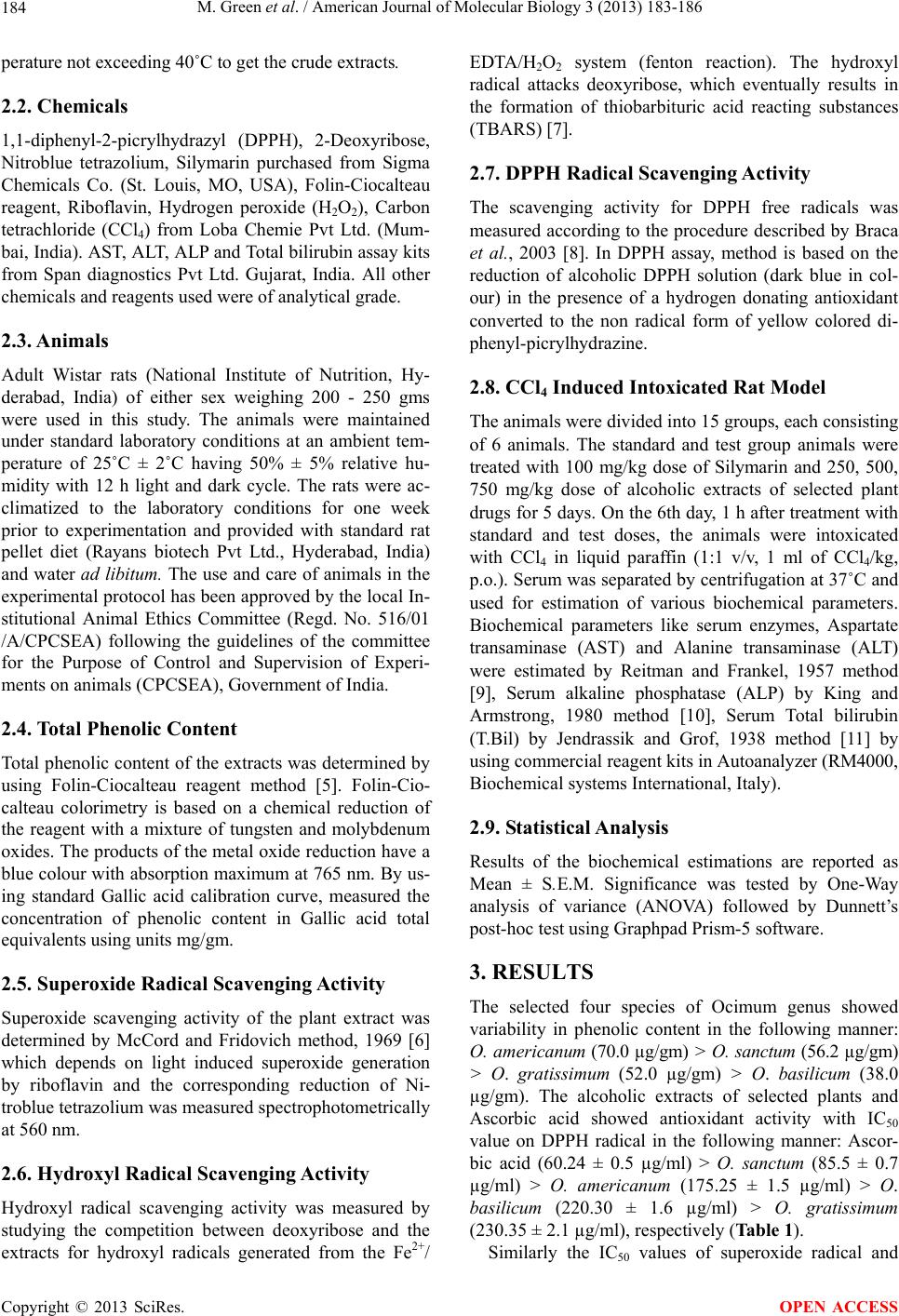
M. Green et al. / American Journal of Molecular Biology 3 (2013) 183-186
184
perature not exceeding 40˚C to get the crude extracts.
2.2. Chemicals
1,1-diphenyl-2-picrylhydrazyl (DPPH), 2-Deoxyribose,
Nitroblue tetrazolium, Silymarin purchased from Sigma
Chemicals Co. (St. Louis, MO, USA), Folin-Ciocalteau
reagent, Riboflavin, Hydrogen peroxide (H2O2), Carbon
tetrachloride (CCl4) from Loba Chemie Pvt Ltd. (Mum-
bai, India). AST, ALT, ALP and Total bilirubin assay kits
from Span diagnostics Pvt Ltd. Gujarat, India. All other
chemicals and reagents used were of analytical grade.
2.3. Animals
Adult Wistar rats (National Institute of Nutrition, Hy-
derabad, India) of either sex weighing 200 - 250 gms
were used in this study. The animals were maintained
under standard laboratory conditions at an ambient tem-
perature of 25˚C ± 2˚C having 50% ± 5% relative hu-
midity with 12 h light and dark cycle. The rats were ac-
climatized to the laboratory conditions for one week
prior to experimentation and provided with standard rat
pellet diet (Rayans biotech Pvt Ltd., Hyderabad, India)
and water ad libitum. The use and care of animals in the
experimental protocol has been approved by the local In-
stitutional Animal Ethics Committee (Regd. No. 516/01
/A/CPCSEA) following the guidelines of the committee
for the Purpose of Control and Supervision of Experi-
ments on animals (CPCSEA), Government of India.
2.4. Total Phenolic Content
Total phenolic co ntent of the extracts was determined by
using Folin-Ciocalteau reagent method [5]. Folin-Cio-
calteau colorimetry is based on a chemical reduction of
the reagent with a mixture of tungsten and molybdenum
oxides. The products of the metal oxide reduction have a
blue colour with absorption maximum at 765 nm. By us-
ing standard Gallic acid calibration curve, measured the
concentration of phenolic content in Gallic acid total
equivalents using units mg/gm.
2.5. Superoxide Radical Scavenging Activity
Superoxide scavenging activity of the plant extract was
determined by McCord and Fridovich method, 1969 [6]
which depends on light induced superoxide generation
by riboflavin and the corresponding reduction of Ni-
troblue tetrazolium was measured spectrophotometrically
at 560 nm.
2.6. Hydroxyl Radical Scavenging Activity
Hydroxyl radical scavenging activity was measured by
studying the competition between deoxyribose and the
extracts for hydroxyl radicals generated from the Fe2+/
EDTA/H2O2 system (fenton reaction). The hydroxyl
radical attacks deoxyribose, which eventually results in
the formation of thiobarbituric acid reacting substances
(TBARS) [ 7 ].
2.7. DPPH Radical Scavenging Activity
The scavenging activity for DPPH free radicals was
measured according to the procedure described by Braca
et al., 2003 [8]. In DPPH assay, method is based on the
reduction of alcoholic DPPH solution (dark blue in col-
our) in the presence of a hydrogen donating antioxidant
converted to the non radical form of yellow colored di-
phenyl-picrylhydrazine.
2.8. CCl4 Induced Intoxicated Rat Model
The animals were divided into 15 groups, each consisting
of 6 animals. The standard and test group animals were
treated with 100 mg/kg dose of Silymarin and 250, 500,
750 mg/kg dose of alcoholic extracts of selected plant
drugs for 5 days. On the 6th day, 1 h after treatment with
standard and test doses, the animals were intoxicated
with CCl4 in liquid paraffin (1:1 v/v, 1 ml of CCl4/kg,
p.o.). Serum was separated by centrifugation at 37˚C and
used for estimation of various biochemical parameters.
Biochemical parameters like serum enzymes, Aspartate
transaminase (AST) and Alanine transaminase (ALT)
were estimated by Reitman and Frankel, 1957 method
[9], Serum alkaline phosphatase (ALP) by King and
Armstrong, 1980 method [10], Serum Total bilirubin
(T.Bil) by Jendrassik and Grof, 1938 method [11] by
using commercial reagent kits in Aut oanalyzer (RM4000,
Biochemical systems International, Italy).
2.9. Statistical Analysis
Results of the biochemical estimations are reported as
Mean ± S.E.M. Significance was tested by One-Way
analysis of variance (ANOVA) followed by Dunnett’s
post-hoc test using Graphpad Prism-5 softw are.
3. RESULTS
The selected four species of Ocimum genus showed
variability in phenolic content in the following manner:
O. americanum (70.0 µg/gm) > O. sanctum (56.2 µg/gm)
> O. gratissimum (52.0 µg/gm) > O. basilicum (38.0
µg/gm). The alcoholic extracts of selected plants and
Ascorbic acid showed antioxidant activity with IC50
value on DPPH radical in the following manner: Ascor-
bic acid (60.24 ± 0.5 µg/ml) > O. sanctum (85.5 ± 0.7
µg/ml) > O. americanum (175.25 ± 1.5 µg/ml) > O.
basilicum (220.30 ± 1.6 µg/ml) > O. gratissimum
(230.35 ± 2.1 µg/ml) , respectively (Table 1).
Similarly the IC50 values of superoxide radical and
Copyright © 2013 SciRes. OPEN ACCESS